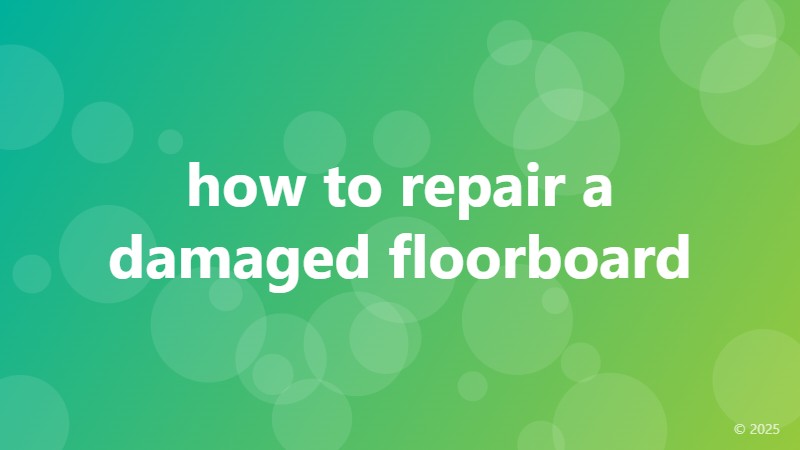how to repair a damaged floorboard
 ```html
```html
Assessing the Damage: The First Step in Floorboard Repair
Before you even think about grabbing your tools, you need to carefully assess the damage to your floorboard. This crucial first step will determine the best repair method and the materials you'll need. Is the damage superficial, like a scratch or small dent? Or is it more serious, involving cracks, significant splintering, or even rot? Take your time to thoroughly examine the affected area. Note the size and depth of the damage, the type of wood, and the overall condition of the surrounding floorboards. Accurate assessment will save you time, money, and frustration in the long run. Take photos to help you remember the details and to track your progress.
Gathering Your Tools and Materials: Preparing for the Repair
The tools and materials you'll need will vary depending on the extent of the damage. However, here's a list of common essentials for most floorboard repairs: wood filler (matching the floorboard color as closely as possible), sandpaper (various grits), a putty knife or small spatula, a chisel (for more serious damage), wood glue, clamps (for holding pieces together while the glue dries), a hammer, a tack hammer (if reinstalling nails), finishing nails or screws, wood stain (if needed to match the existing floor), and a brush or rag for applying stain. Always remember safety first! Wear safety glasses and a dust mask, especially when sanding.
Minor Repairs: Addressing Scratches and Small Dents
For minor scratches and small dents, wood filler is your best friend. Clean the affected area thoroughly, removing any dust or debris. Apply the wood filler, using your putty knife to smooth it out and level it with the surrounding floorboard. Allow it to dry completely according to the manufacturer's instructions. Once dry, gently sand the area smooth, starting with a coarser grit sandpaper and gradually moving to a finer grit for a smooth finish. Finally, apply a matching wood stain, if necessary, to blend the repair seamlessly with the rest of the floor.
Major Repairs: Tackling Cracks and Splintering
More significant damage, like cracks or splintering, requires a more involved approach. If the crack is relatively small, you can often repair it with wood glue and clamps. Clean the crack thoroughly, apply wood glue to both sides, and clamp the pieces together tightly. Allow the glue to dry completely. Once dry, sand the area smooth and apply wood filler, if needed, to fill any gaps. For larger cracks or significant splintering, you may need to replace a section of the floorboard entirely. This involves carefully removing the damaged section and replacing it with a new piece of matching wood.
Replacing a Damaged Floorboard: A Step-by-Step Guide
Replacing a damaged floorboard is a more challenging task, but it's often necessary for extensive damage. Start by carefully removing the damaged board using a chisel and hammer. Be cautious not to damage the surrounding floorboards. Once removed, measure the damaged area accurately and cut a new piece of wood to match. Apply wood glue to the edges of the new board and carefully fit it into place. Secure it with finishing nails or screws, countersinking them slightly below the surface. Fill the nail holes with wood filler, sand smooth, and stain to match the existing floor for a flawless finish. Remember to check your local building supply stores for matching floorboards.
Finishing Touches: Ensuring a Professional Look
After completing the repair, take a step back and assess your work. Are there any areas that need further sanding? Does the stain need a second coat? Pay close attention to detail. A little extra effort in this final stage will ensure a professional-looking repair that will last for years to come. Remember, patience is key! Take your time and don't rush the process. With careful attention to detail, you can restore your damaged floorboards to their former glory.
Prevention is Key: Maintaining Your Floorboards
Regular maintenance can significantly reduce the risk of future damage. Avoid dragging heavy objects across your floorboards, and use protective pads under furniture legs. Regularly clean your floors with a soft broom or vacuum cleaner to prevent dust and debris build-up. And consider applying a protective finish, like polyurethane, to help prevent scratches and other damage. Taking these preventative measures will help keep your floorboards looking their best for years to come.
```